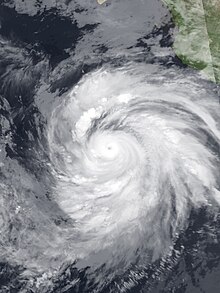Hurricane Elida (2002)
 Elida at peak intensity on July 25 | |
| Meteorological history | |
|---|---|
| Formed | July 23, 2002 |
| Remnant low | July 30, 2002 |
| Dissipated | July 31, 2002 |
| Category 5 major hurricane | |
| 1-minute sustained (SSHWS/NWS) | |
| Highest winds | 160 mph (260 km/h) |
| Lowest pressure | 921 mbar (hPa); 27.20 inHg |
| Overall effects | |
| Fatalities | None |
| Damage | None |
| IBTrACS | |
Part of the 2002 Pacific hurricane season | |
Hurricane Elida was the first of three
Elida developed on July 23, 2002, to the southwest of Mexico. The hurricane moved westward due to a high pressure ridge while undergoing two eyewall replacement cycles: the first was around peak intensity and was completed when the hurricane moved over cooler waters, and the second was a brief cycle shortly after the hurricane began to weaken. The last advisory was issued while the hurricane was west of Mexico, but it was not until the remnants were west of Los Angeles, California that they finally dissipated. Elida's rapid intensification and unsteady weakening after reaching its peak intensity caused large errors in the intensity forecasting of the hurricane by the United States–based National Hurricane Center. Despite this, the track forecasts for Elida were better than usual compared to the prior ten–year average.
Meteorological history

Tropical storm (39–73 mph, 63–118 km/h)
Category 1 (74–95 mph, 119–153 km/h)
Category 2 (96–110 mph, 154–177 km/h)
Category 3 (111–129 mph, 178–208 km/h)
Category 4 (130–156 mph, 209–251 km/h)
Category 5 (≥157 mph, ≥252 km/h)
Unknown
Elida formed from a tropical wave that left the coast of Africa on July 13. The wave moved uneventfully through the Atlantic Ocean and the Caribbean Sea, emerging over the Pacific Ocean on July 21. The wave began organizing the next day, becoming Tropical Depression Six-E on July 23 while 350 mi (560 km) south-southeast of Puerto Escondido, Mexico.[1] The depression was predicted to move westward due to the presence of a ridge of high pressure which was also controlling the movement of Hurricane Douglas.[2] Due to low shear and warm ocean waters, it was predicted that the depression would reach hurricane strength in 48 hours.[2] The depression began rapid intensification while moving westward,[1] and only six hours after being recognized as a depression, the system was upgraded to Tropical Storm Elida while displaying banding features and a central dense overcast. The forecast was revised, now predicting the storm to attain hurricane strength the next day.[3]
The storm continued to rapidly intensify and gradually developed a banding

Afterward, the hurricane began to weaken in an irregular fashion. After the inner eyewall dissolved, the intensity of the hurricane decreased to a low-level Category 3 storm, with winds of 120 mph (190 km/h).
Impact and observation
Although the powerful winds and rains associated with the Hurricane Elida remained far offshore of Mexico, the Tropical Cyclone Report issued by the National Hurricane Center mentioned the likeliness that Elida caused large swells and waves to hit the Mexican shore. However, no reports of damage or casualties linked to Elida were received and no land advisories were ever needed for the hurricane.[1] The only report anywhere near the storm came from the "New Century 1" vehicle carrier ship (call sign "H9LA"), which was 230 mi (370 km) from the center of the hurricane. The ship reported winds of 40 mph (64 km/h) and a pressure of 1008.5.[1]
While the track errors associated with forecasting the hurricane were lower than the errors in the period between 1992 and 2001, Elida's intensity proved to be hard to predict, leading to large errors in NHC forecasts. The errors in the forecast period except for the 72‑hour period were worse than the long-term average. The large errors in intensity forecasts were blamed on the rapid intensification of the hurricane to 160 mph (260 km/h) winds and the unsteady weakening after reaching peak intensity.[1]
When the MERIS sensor aboard the European Space Agency's satellite Envisat observed and recorded Hurricane Elida at peak intensity, it was the first time that the sensor had observed a hurricane. The sensor was originally designed primarily for recording oceanic biology and water quality as well as land vegetation, clouds, and water vapor.[18]
See also
References
- ^ a b c d e f g h i Jack Beven (2002). "Hurricane Elida Tropical Cyclone Report". Archived from the original on 2008-09-22. Retrieved 2007-01-13.
- ^ a b Avila (2002). "Tropical Depression Six-E Discussion Number 1". Retrieved 2007-01-13.
- ^ Avila (2002). "Tropical Storm Elida Discussion Number 2". Retrieved 2007-01-13.
- ^ Beven (2002). "Tropical Storm Elida Discussion Number 3". Retrieved 2007-01-13.
- ^ Franklin (2002). "Hurricane Elida Discussion Number 4". Retrieved 2007-01-13.
- ^ Avila (2002). "Hurricane Elida Discussion Number 5". Retrieved 2007-01-13.
- ^ Avila (2002). "Hurricane Elida Discussion Number 6". Retrieved 2007-01-13.
- ^ Franklin (2002). "Hurricane Elida Discussion Number 8". Retrieved 2007-01-13.
- ^ Franklin (2002). "Hurricane Elida Discussion Number 9". Retrieved 2007-01-13.
- ^ Beven (2002). "Hurricane Elida Discussion Number 11". Retrieved 2007-01-13.
- ^ Avila (2002). "Hurricane Elida Discussion Number 14". Retrieved 2007-01-13.
- ^ Beven (2002). "Hurricane Elida Discussion Number 15". Retrieved 2007-01-13.
- ^ Lawrence (2002). "Tropical Storm Elida Discussion Number 19". Retrieved 2007-01-13.
- ^ Stewart (2002). "Tropical Storm Elida Discussion Number 20". Retrieved 2007-01-13.
- ^ Rappaport (2002). "Tropical Depression Elida Discussion Number 25". Retrieved 2007-01-13.
- ^ Lawrence (2002). "Tropical Depression Elida Discussion Number 27". Retrieved 2007-01-13.
- ^ Beven, Franklin, Lawrence, Pasch, and Avila (2002). "Monthly Tropical Weather Summary". Retrieved 2007-01-13.
{{cite web}}: CS1 maint: multiple names: authors list (link) - ^ European Space Agency (2002). "Envisat's MERIS captures image of Hurricane Elida". Retrieved 2007-01-13.

